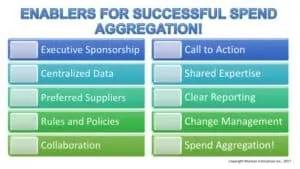Aggregating your procurement spend for the purpose of delivering greater value is a sound objective. Theoretically you should be able to generate better service, better terms and conditions, and better cost. Therefore you should enable spend aggregation.
Yet there can be many obstacles in your way to achieving this seemingly simple goal. Loss of control, fear of job loss, questionable benefits, and a perceived loss of margin are some of the obstacles you may run across. We discussed these in greater detail in our post Procurement (Part 1!) – The Spend Aggregation Obstacle Course!
You may be trying to aggregate spend within your company or across companies, or you are trying to outsource this to a Group Purchasing Organization (GPO). To overcome the Spend Aggregation obstacles there are a series of enablers you need to enact to make this successful.
Spend Aggregation Enablers
First I’d like to be clear that it doesn’t matter what your situation is. You may be just trying to get your arms around the spend within your company. Or you may have just acquired another company and you are trying to combine spend between the two companies.
Your parent company may be working to consolidate spend across all of their subsidiaries. Or perhaps a Group Purchasing Organization (GPO) came knocking at your door with a compelling value proposition.
The issues that you have are much the same across these scenarios. The names and faces may be different but the disruptive behaviours are common.
I have experienced this challenge from many sides of the issue. I have been in the Procurement organization trying to get our arms around spend. I have been in an acquiring company trying to aggregate spend with our newly acquired partner. I’ve been in a subsidiary with a parent company trying to aggregate spend across sister companies. And I’ve also been the guy trying to sell spend aggregation services to other companies.
If you are leading this effort and you see the potential for delivering great value to your boss and your stakeholders you need a path forward. So how do you position your organization to get past these blockers?
Executive Sponsorship
To rally your organization around this effort you truly need an Executive Sponsor. This may be the head of Procurement, the CFO, the COO or the CEO.
Your Executive Sponsor needs to have both formal and informal authority. This is because there will be many different reactions to your initiative. You will certainly have those who understand and participate willingly and enthusiastically. But you will have others who will either be kicking and screaming, or worse they will be passive aggressive in their lack of support.
Whatever the situation there are circumstances in which you will need your Executive Sponsor to throw their weight around. Ideally this is done diplomatically and reasonably.
Centralized Data
An enormous obstacle in trying to aggregate spend is disaggregated data. Your organization has many functions, many operations, many facilities, and many financial entities. If you do not have a single view of what you are spending across any given category (eg. freight, I/T, materials, professional services) then you have no control.
And your source of data can not be Accounts Payable. Even though all invoices (hopefully) are paid by A/P collecting data at that point is too late in the process. You need to know what purchase orders are forecasted and outstanding for each spend category.
And you need all of this information at both the most finite level of detail as well as at different levels of aggregation.
In short you require a central database, a data warehouse where all of this data resides. Only then can you create the reports, queries and analyses necessary to define where you can aggregate spend.
Preferred Suppliers and Partnership Program
A spend aggregation program is not about gaining advantages solely for your company so that suppliers and partners are squeezed unrelentingly. Spend aggregation should also be of benefit to your suppliers. And in all cases you must be fair to your suppliers.
In exchange for being a trusted partner of yours, delivering exceptional capabilities across all dimensions, a preferred supplier should also be able to enjoy the benefits when you enable spend aggregation.
You are likely going to need to consolidate and reduce the number of suppliers that you have. But your preferred suppliers, those that are your very best, should be able to see greater business through your and their efforts.
That is a partnership!
Rules and Policies
Depending upon your situation you may need to institute a series of policies or rules that ensure you can consolidate spend and keep it consolidated.
We’ve all heard of, if not been a part of, “rogue buying” behaviours. There may be reasons behind why this continues but you need to put a stop to it. It can undermine the higher objectives that you have. It will send a signal to suppliers that you are not in control. And your program will crumble underneath you.

I am aware of organizations that have put very firm policies and controls in place to stop rogue buying. In some cases systemic, centralized control over authorization of purchase orders will stop most of this behaviour.
Additionally people make rogue buying issues elements of personal performance appraisals. And in the extreme companies make rogue buying behaviour a condition of employment. These situations make it difficult to enable spend aggregation.
Collaboration Strategies
If you have parts of your organization that have historically managed their own spend you need to bring them onboard constructively. There are very likely many local rules, supplier relationships, and conditions that must be taken in to account. Just swooping in and telling these people that you are now going to select suppliers and negotiate for them won’t work.
You must have a collaborative solution. You still need to take into account their specific needs. Further you may want to involve them in the larger decision-making processes.
Inclusion is a better strategy than exclusion when it comes to dealing with entities across your organization.
Call To Action
Finally it is appropriate that you have a clear Call to Action. And this Call to Action must be communicated across the organization. This communication must articulate the objectives that you have for the program. Further the communication must anticipate and address employee concerns.
Employees will be concerned about potential job loss. They will be concerned about a loss of control or diminished responsibilities.
Whatever the situation your Call to Action must include open and honest communication about the objectives and the potential impacts.
Sharing Expertise
Procurement people are proud professionals. And they often don’t trust that someone can negotiate better than they can even if their spend levels are lower.
If you have a central organization or a GPO that is now going to aggregate spend it is appropriate that you share their expertise with the larger company organization.
People will respect those who can demonstrate that they have the expertise to do the job. This will go a long way to building a trust which may have been lost along the way. And you may find that some of the local people who did this job may be great additions to the central team.
Don’t be afraid to share expertise. If you are then you probably aren’t ready to aggregate spend.
Clear Reporting
The organizations that are losing control of their spend to a central team have every right to get reports showing the benefits that are going to accrue to them. The Finance organization, in my experience, should always be the auditor and arbiter of this reporting to ensure accuracy and objectivity.
There will be concerns as to whether the spend aggregation program is truly working. And the only way to show that concretely is to communicate the results regularly and consistently at all levels.
If there are shortfalls in some cases then the reporting will highlight that. But that will only initiate a set of actions to improve those gaps.
A Change Management Program
As with any change there will be people who embrace it and those who struggle with it. You can not let this just run its own course.
A specific Change Management program, often with the leadership of HR, will serve you well in terms of getting people across the organization to understand and handle the change you are leading.
Enable Spend Aggregation in Conclusion
Spend Aggregation has tremendous potential. Intuitively the rewards should be enormous. However there are many real and perceived obstacles to making it successful.
Whether they are landmines to be avoided or hurdles to be overcome, these obstacles must be addressed for any Spend Aggregation initiative to succeed.
By proactively implementing strategies to enable Spend Aggregation you will dramatically increase your chances of success!



In a previous company I was a local purchasing manager faced with a global purchasing office supply initiative. I was pushed “for the greater good” to move from a local guy to Office Max on a corporate account. The savings for my facility were negligible, but I was told this was for the greater good. Delivery was subcontracted by Office Max under the terms of the corporate agreement. After a while the powers to be decided they didnt want to drive a box truck 90 miles round trip to deliver a box of pens and a few boxes of paper. So they arbitrarily decided to not deliver in the promised window waiting to get more items into the box truck. Meanwhile our fax machine locked up because it ran out of paper and we were held hostage with 50+ faxes we could not get. I ended up calling the other guy back to get us fax paper and renegotiated the entire spend for lower prices. He was grateful to get the business back and it was exactly what I needed to get leadership to abandon the higher calling. Several times in my career I have been forced to tell internal customers that our prices were going up because corporate purchasing was taking over certain commodities. It never sat well, but I did my best to support it until it became a hindrance to our day to day operations. There used to be such a thing as “Total Cost of Ownership”. The money lost on missing faxes far exceeded any possible pennies we saved on the 10 months of being under the corporate agreement.